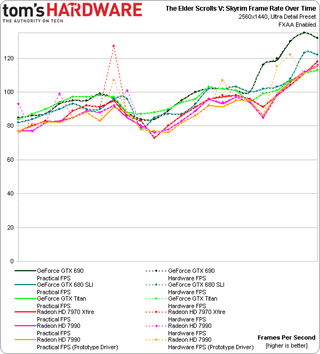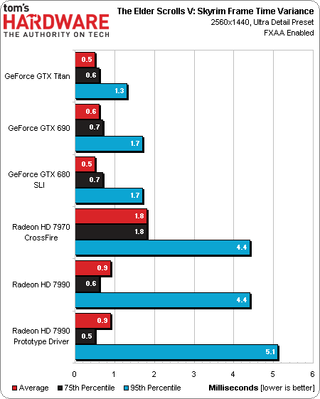AMD Radeon HD 7990: Eight Games And A Beastly Card For $1,000
We've been waiting for this since 2011. AMD is ready to unveil its Radeon HD 7990, featuring a pair of Tahiti graphics processors. Can the dual-slot board capture our hearts with great compute and 3D performance, or does Nvidia walk away with this round?
Results: The Elder Scrolls V: Skyrim

Long ago we established that Skyrim is predominantly platform-bound. Big, dual-GPU graphics cards are largely wasted on this game, which is why roughly 11 FPS separate the top and bottom finishers.
This time around, Nvidia finishes first, second, and third, albeit by a symbolically-high frame rate and an imperceptibly-low delta.

All of these cards largely track together during our 25-second run. AMD’s boards exhibit some divergence between what the cards render and what shows up on-screen. Using our FCAT analysis tools, we see that those dips are caused by dropped frames, though the impact isn’t worrying.

Skyrim is the third benchmark in our suite with deliberate tuning by AMD to optimize frame time latency. The result is a super-tight range from the Radeon HD 7990. Our 95th percentile numbers only jump because of spikes that occur intermittently throughout the run (as high as ~64 ms in one case).
Two Radeon HD 7970s in CrossFire exhibit comparable 95th percentile latencies. But a wider range through the rest of the run translates to greater average and 75th percentile numbers.
The prototype software demonstrates the same tight latencies on Radeon HD 7990. Slightly lower performance could be related to the driver’s older foundation, though.
I’d call AMD’s work in Skyrim good enough to minimize any disadvantage the Radeons might have suffered previously, though it’s worth noting that Nvidia achieves lower latency numbers across the board.
Stay on the Cutting Edge
Join the experts who read Tom's Hardware for the inside track on enthusiast PC tech news — and have for over 25 years. We'll send breaking news and in-depth reviews of CPUs, GPUs, AI, maker hardware and more straight to your inbox.
Current page: Results: The Elder Scrolls V: Skyrim
Prev Page Results: Hitman: Absolution Next Page Results: Tomb Raider-
blackmagnum If I had 1,000 dollars... I would buy a Titan. Its power efficiency, drivers and uber-chip goodness is unmatched.Reply -
timw03878 Here's an idea. Take away the 8 games at 40 bucks a piece and deduct that from the insane 1000 price tag.Reply -
donquad2001 this test was 99% useless to the average gamer,Test the card at 1900x1080 like most of us use to get a real ideal of what its like,only your unigine benchmarks helped the average gamer,who cares what any card can do at a resolution we cant use anyway?Reply -
cangelini whysoPower usage?Thats some nice gains from the prototype driver.Power is the one thing I didn't have time for. We already know the 7990 is a 375 W card, while GTX 690 is a 300 W card, though. We also know AMD has Zero Core, which is going to shave off power at idle with one GPU shut off. I'm not expecting any surprises on power that those specs and technologies don't already insinuate.Reply -
cangelini donquad2001this test was 99% useless to the average gamer,Test the card at 1900x1080 like most of us use to get a real ideal of what its like,only your unigine benchmarks helped the average gamer,who cares what any card can do at a resolution we cant use anyway?If you're looking to game at 1920x1080, I can save you a ton of money by recommending something less than half as expensive. This card is for folks playing at 2560 *at least.* Next time, I'm looking to get FCAT running on a 7680x1440 array ;)Reply -
hero1 Nice article. I was hopping that they would have addressed the whining but they haven't and that's a shame. Performance wise it can be matched by GTX 680 SLI and GTX 690 without the huge time variance and runt frames. Let's hope they fix their whining issue and FPS without forcing users to turn on V-sync. For now I know where my money is going consider that I have dealt with AMD before:XFX and Sapphire and didn't like the results (whining, artifacts, XF stops working etc). Sorry but I gave the red team a try and I will stick with Nvidia until AMD can prove that they have fixed their issues.Reply
